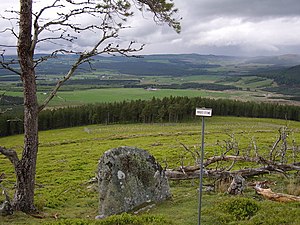Battle of Cromdale
| Battle of Cromdale | |||||||
|---|---|---|---|---|---|---|---|
| Part of the Jacobite rising of 1689 | |||||||
 The Piper's Stone, a boulder upon which a mortally wounded Jacobite piper played music to encourage his comrades | |||||||
| |||||||
| Belligerents | |||||||
|
|
| ||||||
| Commanders and leaders | |||||||
|
|
| ||||||
| Strength | |||||||
| 2000 | 800 | ||||||
| Casualties and losses | |||||||
| ~100 killed | 400 killed | ||||||
Registered battlefield | |||||||
| Designated | 30 November 2011 | ||||||
| Reference no. | BTL20 | ||||||
Location within Scotland | |||||||
The Battle of Cromdale took place at the Haughs of Cromdale on 30 April and 1 May 1690. The site is on a hillside near the village of Cromdale, Strathspey, historically within the county of Inverness-shire. The battlefield has been included in the Inventory of Historic Battlefields in Scotland and protected by Historic Scotland under the Scottish Historical Environment Policy of 2009.[2]
Background
After their defeat at the
On Buchan's arrival, a meeting of the chiefs and principal officers was held at Keppoch to formulate a plan of action. While some of the clans proposed to submit to the government, this proposition was resisted by Sir Ewen. The meeting unanimously resolved to continue the war, but not until the labours of the spring season were complete in the Highlands. The general muster of the clans was postponed. In the meantime, a detachment of 1,200 infantrymen was to be placed at Buchan's disposal to weaken the enemy's quarters along the borders of the Lowlands.
General Buchan advanced his men through
Battle
Buchan was met at Cromdale, near what is now the town of Grantown-on-Spey, by a larger government force under Sir Thomas Livingstone, commander of the garrison of Inverness, who was accompanied by local Grant guides. As Livingstone approached with his men, on the opposite bank of the Spey, the Jacobite forces started to retreat. Livingstone's cavalry crossed the river and intercepted the Jacobites who made a brief stand at the foot of the hill of Cromdale. However, a thick fog came down the side of the mountain and enveloped the outnumbered Jacobites, compelling Livingstone to discontinue the pursuit. According to reports, the Highlanders had 400 men killed and taken prisoner. Livingstone's losses were reported as between none and 100 killed.
A group of around 100 men, who had separated from the main Jacobite force, crossed the Spey the following day. After being pursued by some of Livingstone's men, they were overtaken and dispersed on the moor of Granish near Aviemore, where some of them were killed. They attempted to seize the castle of Lochinclan, but their attack was repelled by the proprietor and his tenants.
Aftermath
The defeat at Cromdale effectively ended the
The last verse reads:
The loyal Stuarts, with Montrose,
So boldly set upon their foes,
And brought them down with Highland blows
Upon the Haughs of Cromdale.
Of twenty-thousand Cromwell's men,
a thousand fled to Aberdeen,
The rest of them lie on the plain,
They're on the Haughs of Cromdale.
Of twenty-thousand of Cromwell's men,
a-thousand fled to Aberdeen,
The rest of them lie on the plain,
They're on the Haughs of Cromdale.
Notes and references
- ^ Site Record for Cromdale, Royal Commission on the Ancient and Historical Monuments of Scotland
- ^ "Inventory battlefields". Historic Scotland. Retrieved 12 April 2012.
- ^ An officer in the Army. "Memoirs of the Lord Viscount Dundee." London: Robert Chapman 1818. p. 23
- ^ “Coulnakyle” nethybridge.com. Retrieved 5 October 2019.
- ^ “Coulnakyle” Galbraith. Retrieved 28 September 2019.
- ^ “In the Shadow of Cairngorm XVII. Coulnakyle and its Memories” Electric Scotland. Retrieved 5 October 2019.
- ^ Silverman, Jerry (1991). Songs of Scotland: 86 Favourite Scottish Songs and Ballads. Mel Bay Publications. p. 58.
- ^ Hogg, James (1819). The Jacobite Relics of Scotland: Being the Songs, Airs, and Legends, of the Adherents to the House of Stuart. London: Oliver & Boyd. p. 157.
External links

